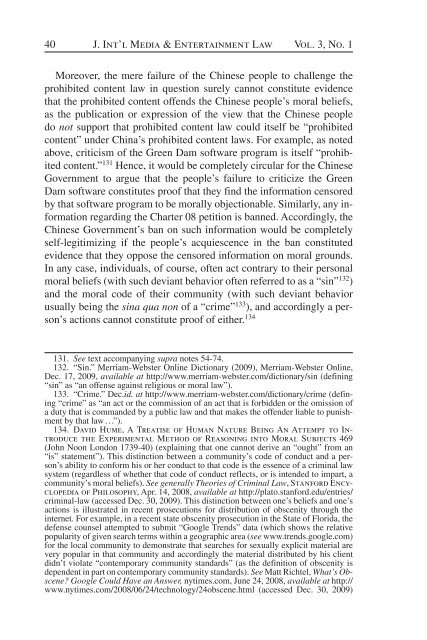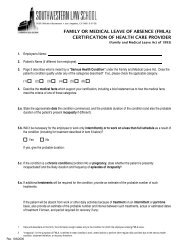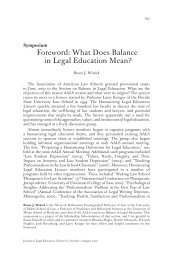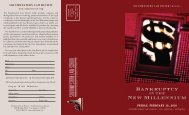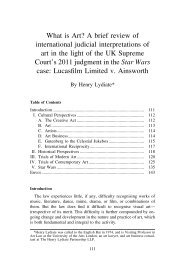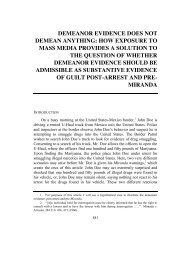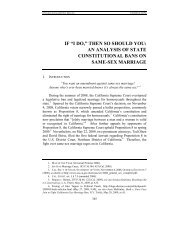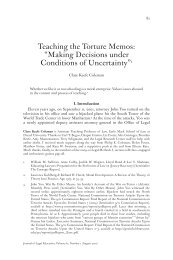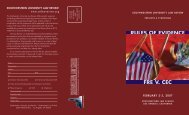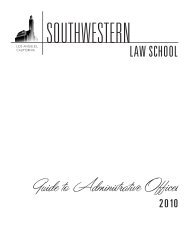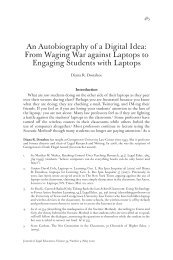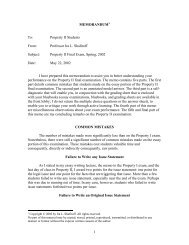Censoring the Censors in the WTO - Southwestern Law School
Censoring the Censors in the WTO - Southwestern Law School
Censoring the Censors in the WTO - Southwestern Law School
You also want an ePaper? Increase the reach of your titles
YUMPU automatically turns print PDFs into web optimized ePapers that Google loves.
40 J. Int’l Media & Enterta<strong>in</strong>ment <strong>Law</strong> Vol. 3, No. 1<br />
Moreover, <strong>the</strong> mere failure of <strong>the</strong> Ch<strong>in</strong>ese people to challenge <strong>the</strong><br />
prohibited content law <strong>in</strong> question surely cannot constitute evidence<br />
that <strong>the</strong> prohibited content offends <strong>the</strong> Ch<strong>in</strong>ese people’s moral beliefs,<br />
as <strong>the</strong> publication or expression of <strong>the</strong> view that <strong>the</strong> Ch<strong>in</strong>ese people<br />
do not support that prohibited content law could itself be “prohibited<br />
content” under Ch<strong>in</strong>a’s prohibited content laws. For example, as noted<br />
above, criticism of <strong>the</strong> Green Dam software program is itself “prohibited<br />
content.” 131 Hence, it would be completely circular for <strong>the</strong> Ch<strong>in</strong>ese<br />
Government to argue that <strong>the</strong> people’s failure to criticize <strong>the</strong> Green<br />
Dam software constitutes proof that <strong>the</strong>y f<strong>in</strong>d <strong>the</strong> <strong>in</strong>formation censored<br />
by that software program to be morally objectionable. Similarly, any <strong>in</strong>formation<br />
regard<strong>in</strong>g <strong>the</strong> Charter 08 petition is banned. Accord<strong>in</strong>gly, <strong>the</strong><br />
Ch<strong>in</strong>ese Government’s ban on such <strong>in</strong>formation would be completely<br />
self-legitimiz<strong>in</strong>g if <strong>the</strong> people’s acquiescence <strong>in</strong> <strong>the</strong> ban constituted<br />
evidence that <strong>the</strong>y oppose <strong>the</strong> censored <strong>in</strong>formation on moral grounds.<br />
In any case, <strong>in</strong>dividuals, of course, often act contrary to <strong>the</strong>ir personal<br />
moral beliefs (with such deviant behavior often referred to as a “s<strong>in</strong>” 132 )<br />
and <strong>the</strong> moral code of <strong>the</strong>ir community (with such deviant behavior<br />
usually be<strong>in</strong>g <strong>the</strong> s<strong>in</strong>a qua non of a “crime” 133 ), and accord<strong>in</strong>gly a person’s<br />
actions cannot constitute proof of ei<strong>the</strong>r. 134<br />
131. See text accompany<strong>in</strong>g supra notes 54-74.<br />
132. “S<strong>in</strong>.” Merriam-Webster Onl<strong>in</strong>e Dictionary (2009), Merriam-Webster Onl<strong>in</strong>e,<br />
Dec. 17, 2009, available at http://www.merriam-webster.com/dictionary/s<strong>in</strong> (def<strong>in</strong><strong>in</strong>g<br />
“s<strong>in</strong>” as “an offense aga<strong>in</strong>st religious or moral law”).<br />
133. “Crime.” Dec.id. at http://www.merriam-webster.com/dictionary/crime (def<strong>in</strong><strong>in</strong>g<br />
“crime” as “an act or <strong>the</strong> commission of an act that is forbidden or <strong>the</strong> omission of<br />
a duty that is commanded by a public law and that makes <strong>the</strong> offender liable to punishment<br />
by that law . . .”).<br />
134. David Hume, A Treatise of Human Nature Be<strong>in</strong>g An Attempt to Introduce<br />
<strong>the</strong> Experimental Method of Reason<strong>in</strong>g <strong>in</strong>to Moral Subjects 469<br />
(John Noon London 1739-40) (expla<strong>in</strong><strong>in</strong>g that one cannot derive an “ought” from an<br />
“is” statement”). This dist<strong>in</strong>ction between a community’s code of conduct and a person’s<br />
ability to conform his or her conduct to that code is <strong>the</strong> essence of a crim<strong>in</strong>al law<br />
system (regardless of whe<strong>the</strong>r that code of conduct reflects, or is <strong>in</strong>tended to impart, a<br />
community’s moral beliefs). See generally Theories of Crim<strong>in</strong>al <strong>Law</strong>, Stanford Encyclopedia<br />
of Philosophy, Apr. 14, 2008, available at http://plato.stanford.edu/entries/<br />
crim<strong>in</strong>al-law (accessed Dec. 30, 2009). This dist<strong>in</strong>ction between one’s beliefs and one’s<br />
actions is illustrated <strong>in</strong> recent prosecutions for distribution of obscenity through <strong>the</strong><br />
<strong>in</strong>ternet. For example, <strong>in</strong> a recent state obscenity prosecution <strong>in</strong> <strong>the</strong> State of Florida, <strong>the</strong><br />
defense counsel attempted to submit “Google Trends” data (which shows <strong>the</strong> relative<br />
popularity of given search terms with<strong>in</strong> a geographic area (see www.trends.google.com)<br />
for <strong>the</strong> local community to demonstrate that searches for sexually explicit material are<br />
very popular <strong>in</strong> that community and accord<strong>in</strong>gly <strong>the</strong> material distributed by his client<br />
didn’t violate “contemporary community standards” (as <strong>the</strong> def<strong>in</strong>ition of obscenity is<br />
dependent <strong>in</strong> part on contemporary community standards). See Matt Richtel, What’s Obscene<br />
Google Could Have an Answer, nytimes.com, June 24, 2008, available at http://<br />
www.nytimes.com/2008/06/24/technology/24obscene.html (accessed Dec. 30, 2009)<br />
3058-088-3pass-02_Wright-r03.<strong>in</strong>dd 40<br />
6/30/2010 12:01:59 PM


